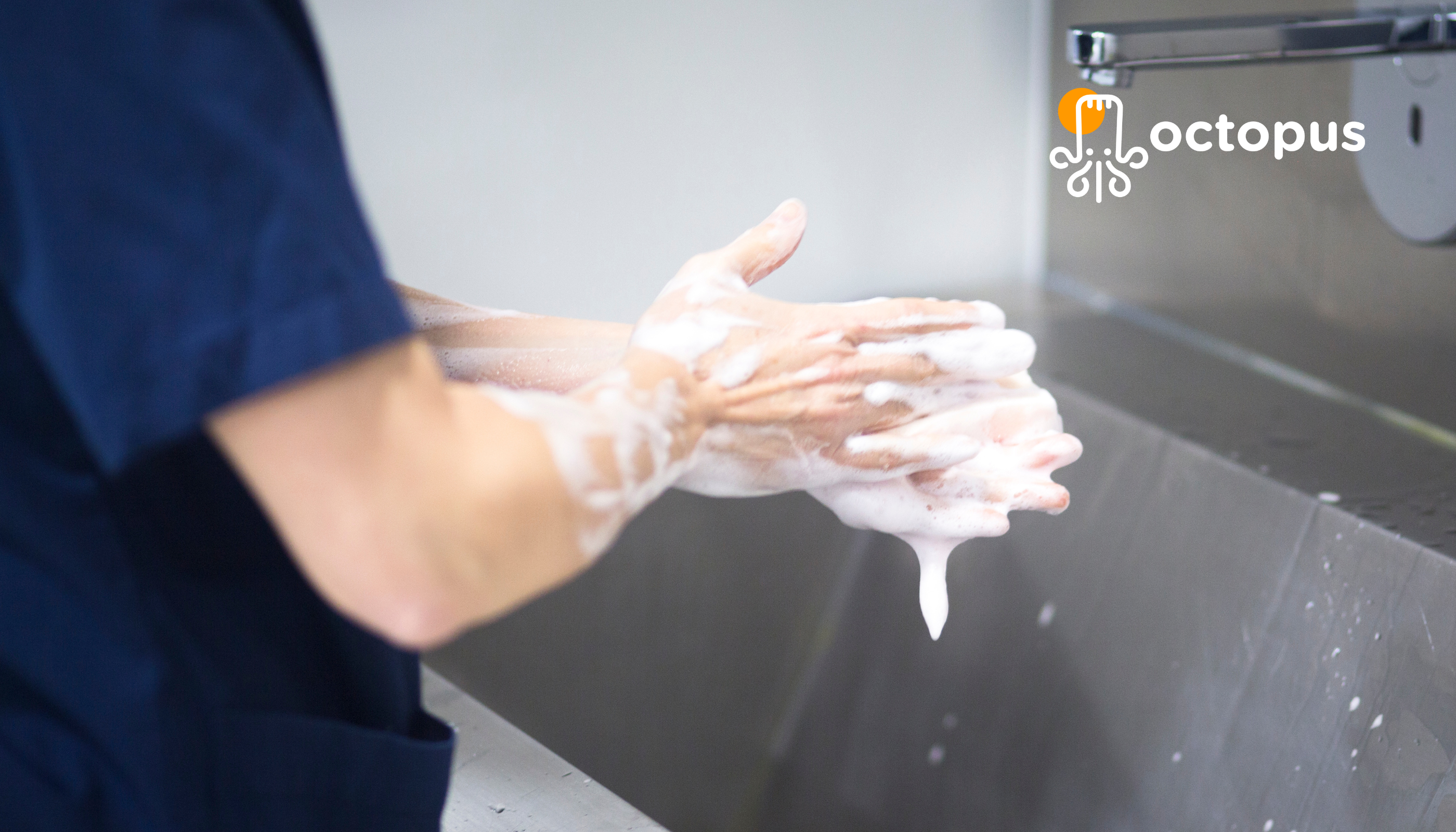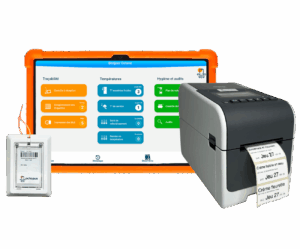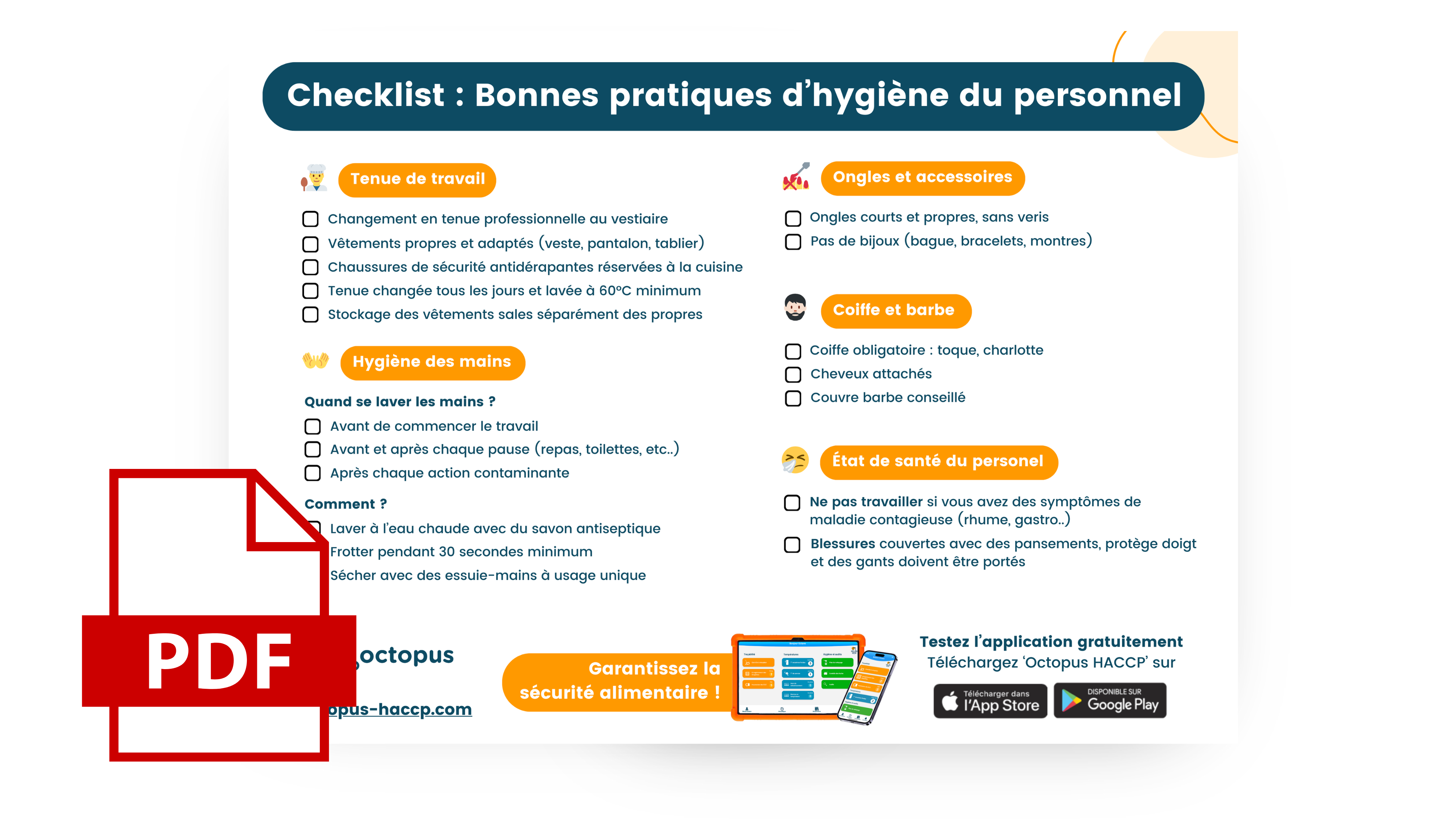Staff hygiene in catering: what are the best practices?
Nettoyer et désinfecter
⏳ Temps de lecture : 6 min
? Mis à jour le : 15/11/2024
In this article, we provide a guide on best hygiene practices for food service staff, while complying with current regulations. Plus, we offer a downloadable PDF checklist of staff hygiene best practices, ready to print and display in staff areas to raise awareness among your team! ✅
Why is staff hygiene important in food service? ?️
In food service, kitchens are often considered high-risk contamination zones due to frequent food handling and processing. ? For this reason, it’s important to implement clearly defined hygiene procedures for staff to prevent any contamination risks. Every staff member working in food production areas must know and follow these hygiene practices. ??
Preventing cross-contamination risks ?
Poor staff hygiene can lead to cross-contamination. In such cases, food coming into contact with surfaces previously contaminated by staff can transfer contamination to consumers. This can be particularly problematic in cases of cross-contamination from allergen-containing dishes to allergen-free dishes. This can have serious consequences if the consumer has allergies. ?
Cross-contamination can lead to food poisoning or transmit diseases (flu, COVID, etc.), thereby endangering customers’ health. In case of incidents, penalties may be imposed by competent authorities, in accordance with current regulations and HACCP standards. ✅
What do regulations say about staff hygiene in catering? ⚖️
Work attire and equipment: What are the requirements in food service? ??
To ensure staff hygiene complies with current regulations, work uniforms and equipment must be appropriate. Kitchen attire serves two purposes: protecting staff when handling utensils and from stains, while also acting as a barrier between staff’s bodies and food products.
Professional clothing: Jackets, pants, and aprons. ?
Dirty work uniforms are contamination vectors. To maintain proper clothing hygiene, several points must be followed:
- Separation between work attire and personal clothing. ?
- Daily uniform changes and regular washing at temperatures above 60°C (140°F). ?
- Uniform storage must be in dedicated changing rooms, protected from dirt. Clean linens must be separated from dirty ones and stored in a clean, dry place.
Separation between work attire and personal clothing: Staff must change into work uniforms at the workplace. Coming to work already dressed is not permitted, as professional attire could become contaminated during the commute. ?
Before each shift, staff must remove all personal clothing and dress in work uniforms in changing rooms. Depending on work station, staff may wear different uniforms adapted to their area (receiving, cold prep, hot prep, service, etc.).
Work attire should never be covered by non-uniform clothing like sweaters or vests. The work uniform must include ✅:
- Jacket ?: Jackets must be closed and made of easy-care fabric. They should also be fire-resistant. Light colors are preferred as they make stains more visible.
- Pants ?: Pants must fully cover legs. Cuffless styles are preferred and they must be fire-resistant for kitchen safety.
- Apron ?: Aprons should preferably be light-colored to show stains. They must be changed regularly as needed, at minimum once per shift to limit contamination risks.
Footwear ?
Regarding footwear, shoes must be work-dedicated. Street shoes or sneakers that have been worn outside (for example during the commute to work) are not permitted. Shoes must be changed in the locker rooms. Their use must be strictly limited to work areas to maintain a clean environment. ?️ These shoes should never leave the premises.
Shoes must be slip-resistant to prevent accidents in wet areas and ensure staff safety. For teams handling heavy objects where drop hazards exist, safety shoes are mandatory. ✅
Hairnets, beard covers… ??♂️
Hairnets: Wearing a hairnet or chef’s hat is mandatory for food service staff. It prevents hair and dandruff from contaminating food preparation areas and limits hand-to-hair contact. Hair must always be tied back and completely covered; bouffant caps are among the best options.
Beard covers: While beards and mustaches are discouraged, they’re not prohibited. For staff with facial hair, using a beard net is strongly recommended (even if not very aesthetic) to prevent hair from falling into food preparations.
Face masks ?
Wearing masks is not mandatory, but has become common practice, especially since the COVID-19 pandemic. Their use may be required to prevent contamination even when staff show mild symptoms like a cold. ?
In certain establishments like institutional catering or sensitive environments, mask-wearing is more frequent and forms part of HACCP-recommended best practices. To be effective, masks must cover both nose and mouth. ✅
Hand hygiene: What are the best practices? ?️
Hand hygiene is one of the most important measures to prevent contamination risks. Hands are frequently responsible for pathogen transmission and are a common source of cross-contamination.
When should you wash your hands? ?
Hand washing should occur after every potentially contaminating action ? to minimize contamination risks and comply with hygiene regulations, for example:
- When arriving at your workstation,
- Before and after using the restroom,
- After eating,
- After smoking,
- After blowing your nose, sneezing or coughing,
- After shaking someone’s hand,
- After handling phones, documents, cash registers, or money,
- After handling trash,
- After receiving or unpacking raw materials,
- After handling raw food products,
- Between handling different food items or when changing preparation areas.
How to properly wash hands? ?
Proper hand washing ensures effective decontamination and reduces food contamination risks. We recommend following these steps ?️:
- Wet hands with warm water.
- Apply sufficient antibacterial soap.
- Scrub all hand surfaces thoroughly: palms, backs of hands, between fingers, nails and wrists for at least 30 seconds.
- Rinse thoroughly under running water.
- Dry hands with a single-use towel or hand dryer. Reusable cloths are prohibited to prevent cross-contamination.
What equipment should be used for hand washing? ?️
For optimal hygiene, staff must have access to handwashing stations placed in strategic locations, such as near restrooms or work areas. Non-manual operated sinks are recommended to minimize contact points. The provided soap should be antibacterial, and nail brushes (either disposable or regularly sanitized) should be available for proper nail hygiene.
Using Gloves in the Kitchen ?
Clean gloves may be used when handling food directly (kneading, mixing ingredients, etc.) to limit pathogen transfer. Important: gloved hands should perform only one task. Gloves must be changed between tasks as they cannot be washed. ❌
Additionally, gloves must be replaced after two hours of continuous use on the same task. Hands must be washed before putting on gloves, and this must be repeated with every glove change and after removal.
Jewelry and Nails ?
Jewelry: Jewelry presents three types of risks:
- Parts of jewelry may break off and fall into food preparations.
- The skin areas covered by jewelry are hard to access, making proper cleaning and disinfection difficult. These areas can become breeding grounds for germs and bacteria. ?
- Jewelry harbors microbes due to hard-to-clean crevices. ?️
- Removing jewelry, washing hands and putting it back is ineffective as the jewelry remains contaminated and can recontaminate skin.
All jewelry is prohibited: rings, bracelets, watches, necklaces, chains, earrings, etc. However, plain wedding bands are permitted, as are thin chains concealed under clothing. Jewelry must be stored in lockers when changing into work attire before entering food preparation areas.
Nails: Regarding nails, they must be short and clean. Like jewelry, they are breeding grounds for bacteria and germs as they easily trap food residues. These contaminants can then end up in food preparations, increasing cross-contamination risks. ?
Nail polish or gel nails present additional risks as polish may chip and fall into food. ?
You can download the PDF summary of best practices for work attire and hand hygiene at the end of this article. Consider displaying it in staff changing areas!
Staff Health and Food Hygiene: How to Prevent Contamination? ?
Staff health is a critical factor in ensuring food safety. An ill person can contaminate work surfaces or even their colleagues.
Monitoring Staff Health Status ✅
Before starting their shift, employees must be in good health. It’s essential to ensure no one shows symptoms of transmissible illnesses like gastroenteritis or flu.
If staff members display such symptoms, they must be excluded from food preparation areas to prevent contamination. Medical clearance is required to confirm their fitness for safe work.
These measures must be included in your Food Safety Management System (FSMS). ?
Enhancing Hygiene Practices ?
For mild symptoms: When mild symptoms like colds or coughs appear (not requiring sick leave), mask-wearing may become mandatory to prevent contamination. Additionally, using disposable gloves can supplement hygiene protocols for sensitive tasks like handling ready-to-eat foods.
For injuries: Any staff injury (cuts, burns, etc.) must be covered with waterproof bandages and finger cots or gloves to prevent food contact. For open wounds or untreatable conditions, employees should be temporarily reassigned or excluded from production areas until healed.
Staff Hygiene Procedures: Download Your PDF ?
To help implement hygiene best practices, we’ve created a comprehensive guide for food service and catering staff, available as a free PDF download. This document provides clear instructions for maintaining impeccable hygiene aligned with HACCP principles.
Simply complete the form to receive and download the PDF directly by email! ?





